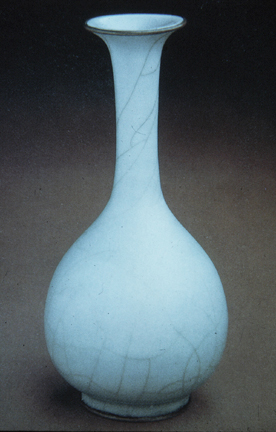
Guan Ware Vase, Southern Song Dynasty
Chinese, ca 12000 CE
ART 198 - HISTORY OF WORLD CERAMICS
| Most highly prized on the Southern Song Dynasty ware was Guan, which literally means 'imperial,' and logically enough, was made exclusively for imperial use. It is thought to have been started by expatriate Northern Song Ru potters who fled the Tartar invasions of the early 12th century, and set up kilns at Hangzhou. This elegant vase shows the austere and quiet beauty so often associated with the best Song pottery. It is a masterpiece of understatement. No decoration is allowed to detract from its simple fusion of form and surface. Porcelain clay is a difficult and unforgiving medium in which to work, and losses are legion as the rigors of the high temperature firing process weed out large numbers of pieces. Porcelain is made from combining feldspar (petuntze) and china clay (kaolin) in the correct proportions and firing the mixture to a temperature high enough to vitrify it. Vitrification means literally to 'become a glass' and at high temperatures the clay fuses into a hard and durable glasslike substance. The Chinese have many poetic names to refer to porcelain, for example, ying qing (shadow blue) and ching bai (clear white), and the variations in color, texture, and translucency have been analyzed endlessly by chemists, artists, and poets. | Guan Ware Vase, Southern Song Dynasty Chinese, ca 12000 CE |
|
|